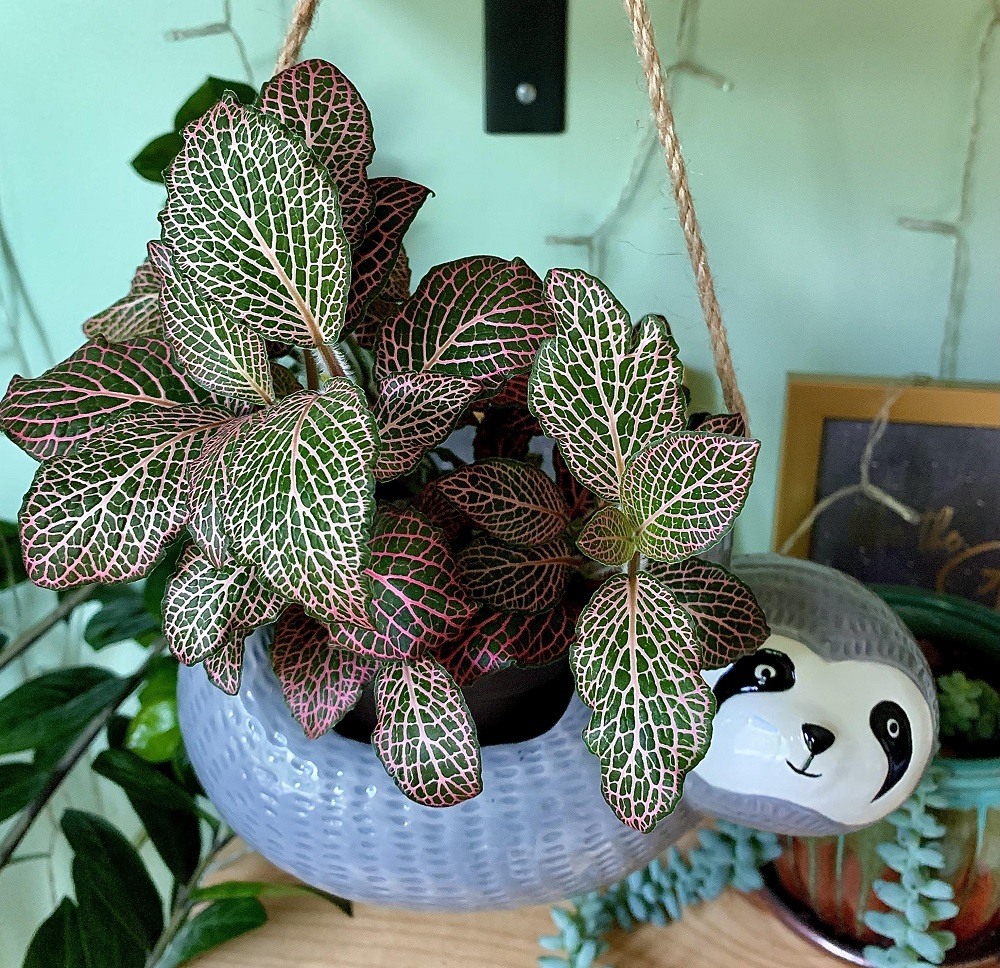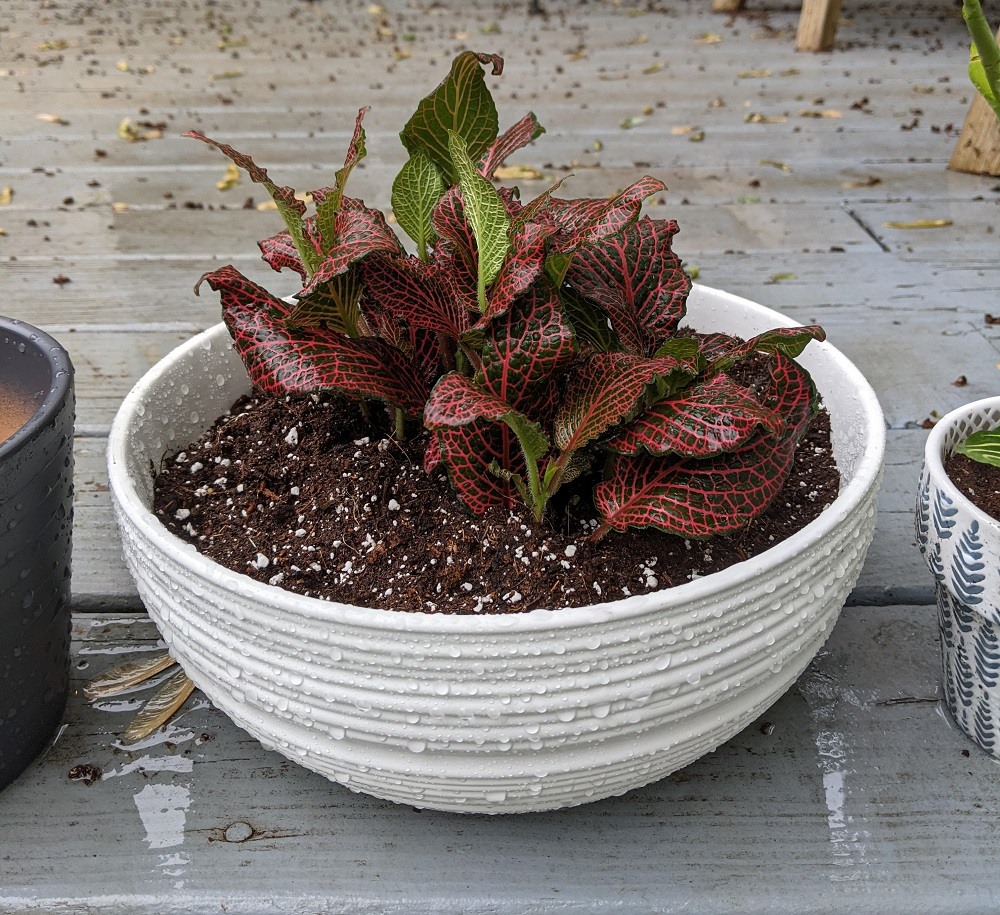A nerve plant is a fittonia cultivar with eye-catching foliages. This houseplant is ideal for hanging baskets, container gardens, and terrariums. Nerve plants are native to tropical rainforests and would prefer similar conditions at home to thrive.
Nerve plant care involves the provision of bright indirect sunlight, high humidity, appropriate watering practice, well-draining soil, and a temperature range of 60-80oF (16-26oC). Use liquid fertilizer to feed fittonia every four-month during spring and summer.
These small plants with attractive foliages can be intimidating to grow and maintain. The information in this article will help you learn how to grow and care for fittonia plants. Take the time to read through and discover the common problems with their respective solutions.
You May Also Like: How to Care for Macodes Petola

What Does Nerve Plant Looks Like?
Fittonia albivenis is the scientific name for nerve plants. The fittonia name comes from the two Irish sisters Elizabeth and Sarah Mary Fitton.
Albivenis is a species name that refers to white veins. Other common names associated with fittonia plants are nerve plant, silver net leaf, silver threads, and silver fittonia.
Fittonia plants are classified into white-veined and red-veined nerve plants. The white-veined nerve plant belongs to the Argyroneura group and red-veined to the Vershaffeltii group.
Nerve plants are ground cover plants and can reach about six inches in height. The ovate foliages can grow up to four inches with a notable striking vein network.
Fittonia plants have deep-green foliages with contrasting veins. But there are other cultivars with different foliage colorations and sizes.
Nerve plants produce small white or red-tinged flowers. Removing these unimpressive flowers will help to showcase their vibrant foliages and conserve energy.
Outdoor nerve plants serve as ground covers, and the indoor counterpart is ideal for hanging baskets or terrariums. I prefer growing my fittonia in the terrarium due to the high humidity.
Dwarf fittonia varieties do best in the terrarium and make the foliages look stunning. Terrariums replicate the tropical forest condition. (Check the Best Terrarium Deals on Amazon).
Nerve Plant Care Details
| Origin | South America |
| Botanical Name | Fittonia albivenis |
| Common Names | Nerve plant Mosaic plant Painted net leaf |
| Maximum Growth (Approx)` | Six inches long |
| Light Requirement | Bright indirect sunlight. Direct sunlight might scorch the leaves. |
| Watering Needs | Maintain consistent soil moisture without getting soggy. |
| Soil Requirement | Lightweight and well-draining potting mix. I prefer peat moss potting soil. |
| Temperature Range | 60-80oF (16-26oC) |
| Humidity Requirement | Above 50% to keep foliages happy and healthy. |
| Fertilizer Application | Every 1-2 months during spring and summer. Use a dilute balanced fertilizer to feed your houseplant. |
| Pruning Requirements | Pinch the shoots to maintain a compact design. |
| Propagation | Stem cuttings. |
| Re-potting | Every 1-2 years to refresh the soil. |
| Pests and Diseases | Pests: Mealybugs Diseases: Root rot due to overwatering. |
| Toxicity | Non-toxic to pets and humans. |
How to Care for Nerve Plant (Fittonia Plants)
Selecting Soil and Pot for Nerve Plants
Potting soil is an essential nerve plant care. Fittonia plants thrive in well-draining soil rich in organic matter and can hold water without getting soggy.
I recommend peat-based potting mixes like the African violet soil mix and a loamy indoor potting soil. The addition of compost helps to boost fertility and moisture retention capabilities.
Do not allow your nerve plant to sit directly in stagnant water. Ensure the pot has drainage holes at the bottom to get rid of excess water.
Re-pot fittonia plants every 1-2 years to refresh the potting soil. Be sure to use small pots since nerve plants have shallow roots.
Nerve Plant Light Requirements
Fittonia plants grow under the dense canopies of the tropical rainforest. Provide your nerve plant with bright indirect sunlight to thrive well.
Low light conditions will make the nerve plants lose vibrant colors. Besides that, it will become leggy, and experience stunted growth in the long run.
Nerve plants are also sensitive to direct sunlight. Excess sunlight will scorch the leaves and even make the nerve plant droopy.
But fittonia plants can tolerate early morning or late evening direct sunlight. Use artificial grow lights (Check Best Deals on Amazon) in rooms receiving low natural light.
Research shows that some fittonia varieties might revert to green or pale colors due to insufficient sunlight exposure. (Source: University of Georgia).
Temperature Range for Nerve Plants
The native habitat of nerve plants has a warm and humid weather climate. The tropical climate allows the fittonia plants to flourish and stay healthy.
Every houseplant enthusiasts need to replicate the tropical climate at home. The best temperature range for nerve plants is 60-80oF (16-26oC).
Hot and cold drafts will ruin the appearance of fittiona leaves. Low temperatures will make the fittonia leaves drop, and high temperatures will cause leaves to curl or droop.
Keep your nerve plant away from air vents, heaters, and radiators. Maintain the standard temperature to foster better health and well-being.
Use a digital thermometer (Check the Best Deals on Amazon) to help detect and monitor indoor temperature changes.
Humidity Requirement for Nerve Plants
Humidity is another vital nerve plant care regime. High humidity and warm conditions are common phenomena in tropical rainforests.
The inadequate humidity level will make the fittonia leaves wither and wilt. Watering and misting the leaves happen to be the best method for reviving the houseplant.
I recommend the use of a humidifier over misting the leaves. The instrument will help boost the indoor humidity level to keep the plant happy and healthy.
Use the automatic humidifier during winter to increase moisture around the plant. Ensure the fittonia plant experience adequate air supply to prevent fungal diseases.
Another excellent option is to place the dwarf fittonia varieties in the terrarium. It creates a humid environment similar to the tropical rainforest.
How to Water a Nerve Plant
Fittonia roots need constant moisture to carry out their physiological activities. Too much water increases the risk of root rot.
The golden rule is to inspect the soil moisture content before watering. Insert the index finger about 2-3 inches of the topsoil. Soak the soil if it is dry.
Fittonia leaves turning yellow are the initial sign of overwatering. Re-pot the houseplant to a pot with well-draining soil. The drainage holes will help to get rid of excess water.
Examine the roots and snip the affected ones with a sterilized pruner. Schedule a strict watering routine to avoid under-watering and overwatering-related issues.
Nerve Plant Fertilizer Requirements
Nerve plants are light-feeders when compared to other tropical plants. Use a dilute liquid fertilizer to feed your houseplant every 1-2 months during spring through fall.
The fertilizer nutrients enhance vegetative growth and lush foliage development. Be sure to flush the soil every four months to prevent the buildup of mineral salts.
Don’t fertilize your fittonia plant during winter due to dormancy issues. It would be best to read my article on How to Make Homemade Fertilizer for Houseplants.
Pruning Nerve Plants
Fittionia plants are prolific growers and vulnerable to becoming leggy. The situation occurs when the houseplant receives uneven natural light.
Use a hand pruner (Check Best Deals on Amazon) to cut the leggy stems. Remember to sterilize the pruner to avoid spreading plant diseases.
Prune the nerve plant tips to promote sideways growth and bushy appearance. Besides that, trim the old or damaged leaves caused by low humidity and overwatering.
Be sure to trim your fittonia plant during spring and early summer. Use the stem cuttings to propagate new plants at home.
Nerve Plant Propagation
Stem cuttings are the most reliable method for propagating nerve plants. Cut a stem from a mature plant about 3-4 inches long. Ensure the stem cut has about two nodes.
Plant the stem cuts in a moist potting mix and create a humid environment. The warmth and soil moisture will promote rooting after 2-3 weeks.
Fittonia Varieties
Fittonia plants come in different cultivars with striking leaf colorations. Below are the common fittonia types to consider growing at home:
Black star mosaic plants have dark green foliages with fewer deep red veins. Frankie nerve plants have pretty pink leaves with dark green edges.
The white Anne nerve plant has dark green leaves with bold white veins. Juanite is a large-leaf fittonia with intricate bright red veins.
The pink angel fittonia plant has dense pink leaves and tends to be compact. Ruby red fittonia plants have variegated and dark green foliages with prominent red veins.
Common Problems and Solutions
Pests
Nerve plants are less vulnerable to pest infestation. But this does not imply that fittonia plants are invincible to insect infestations.
Mealybugs tend to cause more problems to nerve plants. Use a neem oil spray or insecticidal soap spray to eliminate these sap-sucking creatures.
Diseases
Fittonia plants are not susceptible to diseases. Too much moisture around the roots due to overwatering can result in root rot issues.
Uproot the houseplant and examine the roots before re-potting. Trim the affected roots with a sterilized blade and transplant them in a new container with fresh potting mix.
You May Also Read: How to Care for Indoor Orange Tree
Frequently Asked Questions
Are Nerve Plants Toxic?
No. Nerve plants are non-toxic to humans and pets. I recommend keeping your favorite houseplants away from children and pets.
Why Is My Nerve Plant Drooping?
Inappropriate watering routine and heat draft are the possible cause of nerve plant drooping. Examine your fittonia to identify the exact cause before initiating measures to fix it.

Final Word
Fittonia plant is the best for hanging baskets, terrariums, and container gardens. It is a plant with red veins and green leaves that create a lasting impression.
The silver nerve plant care is the same as pink nerve plant care. Take the time to read this fittonia plant care guide for overall understanding.
I hope you enjoyed reading my nerve plant care guide. Use the comment section in case you have inquiries or questions.
